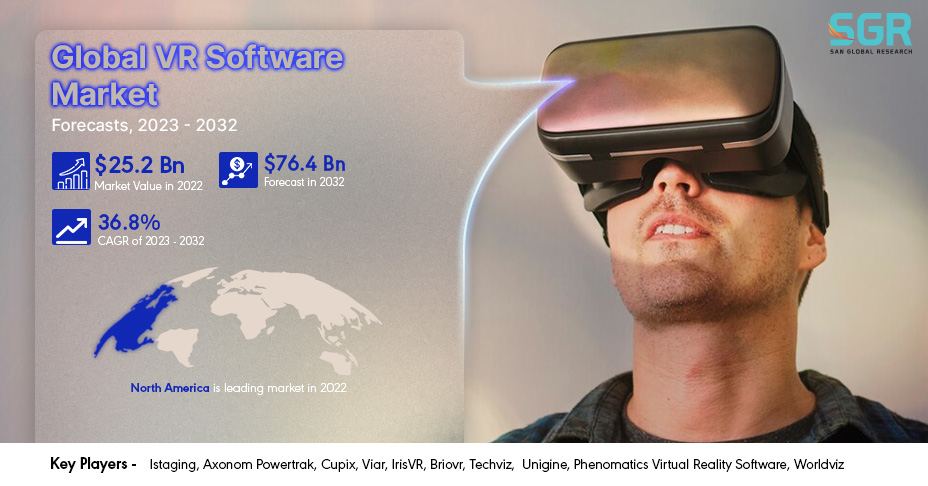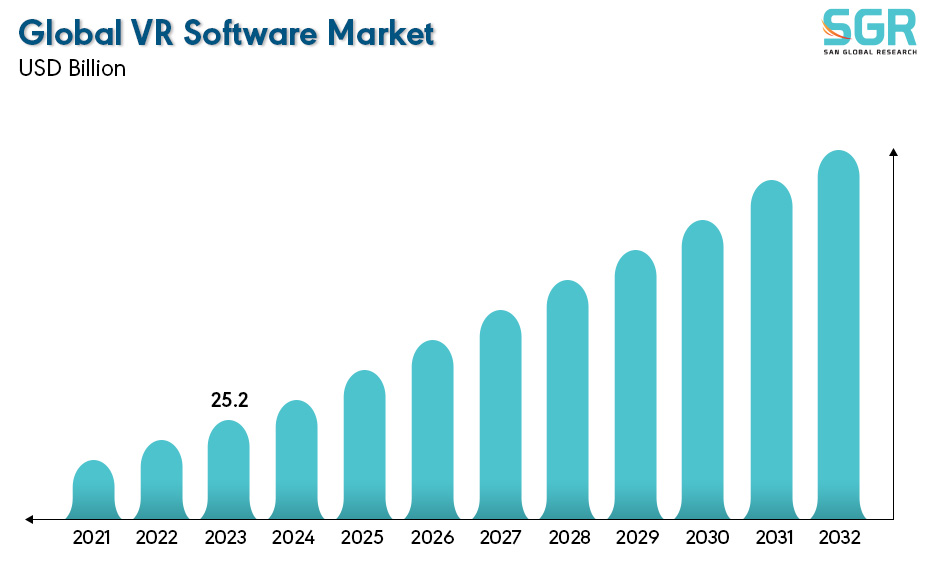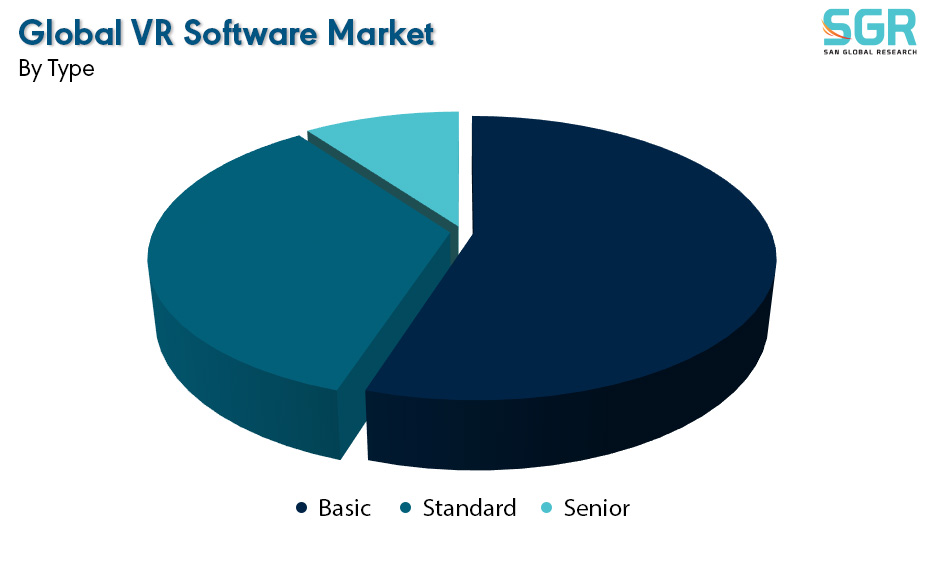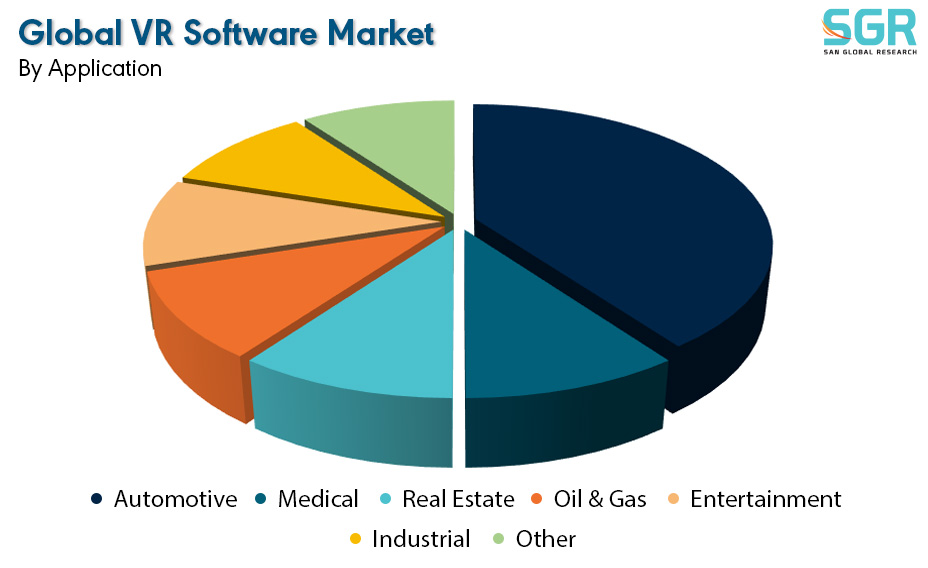Global VR Software Market is estimated to be worth USD 25.2 Billion in 2022 and is projected to grow at a CAGR of 36.8% between 2023 to 2032.

The study has considered the base year as 2022, which estimates the market size of market and the forecast period is 2023 to 2032. The report analyzes and forecasts the market size, in terms of value (USD Billion), for the market. The report segments the market and forecasts it by Type, by Application and by region/country.

The global Virtual Reality (VR) software market has witnessed substantial growth as the digital landscape continues to embrace immersive and interactive experiences. VR software serves as the backbone of virtual reality applications, powering simulations, gaming, education, healthcare, and various other industries. The market is characterized by a diverse range of software offerings, including content creation tools, development platforms, and VR applications across different sectors. The rising consumer interest in virtual reality, coupled with advancements in hardware technology, has propelled the demand for innovative and compelling VR software solutions. Companies are investing in research and development to enhance the realism and functionality of VR experiences, driving competition and innovation within the market. As VR becomes increasingly integrated into various facets of our digital lives, the global VR software market is poised for continued expansion, offering a plethora of opportunities for developers, businesses, and industries looking to leverage the potential of immersive virtual environments.
.jpg)
Region wise Comparison:
In North America, the Virtual Reality (VR) software market has witnessed robust growth, driven by a thriving tech industry and a high level of consumer adoption. The region is home to major players in the VR software development space, contributing to a competitive and innovative market landscape. The demand for VR software spans diverse sectors, including gaming, entertainment, education, and healthcare.
Europe has seen significant traction in the VR software market, with a focus on creating immersive experiences across industries. European countries are actively investing in VR research and development, fostering collaborations between software developers, content creators, and hardware manufacturers. The market is characterized by a growing demand for enterprise VR applications, particularly in training and simulation.
.jpg)
The Asia Pacific region has emerged as a vibrant hub for the VR software market, driven by the rapid adoption of new technologies and a burgeoning gaming culture. Countries like China, Japan, and South Korea are leading the way in VR software development, catering to a diverse range of applications, including gaming, education, and industrial use.
In Latin America, the VR software market is experiencing gradual but steady growth, spurred by an increasing awareness of virtual reality technologies. While the market is still evolving, there is a notable interest in using VR software for gaming, education, and architectural visualization.
Africa is witnessing a nascent yet promising development in the VR software market. Innovations are emerging in areas such as education, healthcare, and tourism, contributing to the region's digital transformation.
The Middle East is showing an increasing interest in the VR software market, driven by a combination of economic diversification and a focus on technological advancements. Countries like the United Arab Emirates are investing in VR applications for sectors such as tourism, real estate, and healthcare.
.jpg)
Segmentation:
The Global VR Software Market is segmented by Type, by Application and by region/country.
By Type:

Based on the type, the Global VR Software Market is bifurcated into Basic, Standard & Senior – where Basic is dominating and ahead in terms of share.
In the global Virtual Reality (VR) software market, several basic types of software play crucial roles in delivering immersive experiences. Content Creation Software is fundamental, empowering developers and creators to design and produce VR content, ranging from games and simulations to educational experiences. Development Platforms provide the tools and frameworks necessary for building VR applications, ensuring compatibility with various hardware devices. VR Content Delivery Software is vital for distributing and streaming VR content efficiently, optimizing the user experience.
By Application:

Based on the Application, the Global VR Software Market is bifurcated into Automotive, Medical, Real Estate, Oil & Gas, Entertainment, and Industrial & Other – where Automotive is dominating and ahead in terms of share.
On the basis of region
• North America
• Europe
• Asia Pacific
• South America and
• Middle East and Africa
In 2022, North America is anticipated to dominate the Global VR Software Market with market revenue of XX USD Million with a registered CAGR of XX%.
Key Players:
The key market players operating in the Global VR Software Market include
• Istaging
• Axonom Powertrak
• Cupix
• Viar
• IrisVR
• Briovr
• Techviz
• Unigine
• Phenomatics Virtual Reality Software
• Worldviz
Drivers:
Growing sector across the globe
The global Virtual Reality (VR) software market is propelled by a convergence of factors contributing to the widespread adoption and continual growth of immersive technologies. One of the primary drivers is the increasing demand for VR in gaming and entertainment, as consumers seek more engaging and realistic experiences. Additionally, advancements in hardware, such as VR headsets and controllers, have expanded the capabilities of VR software, fostering a more immersive and interactive environment. The integration of VR in industries like healthcare, education, and training is also a significant driver, as organizations recognize the potential for simulation and virtual learning applications. Furthermore, the rise of remote work and collaboration has spurred the demand for VR communication and meeting software. As technology continues to evolve, the global VR software market benefits from ongoing innovations, creating new opportunities and use cases that extend beyond entertainment into various aspects of our professional and personal lives.
Opportunity:
Evolving Market
The global Virtual Reality (VR) software market presents a plethora of opportunities as technological advancements and increasing consumer acceptance continue to drive demand. One notable opportunity lies in the expansion of VR applications beyond gaming, with significant growth potential in industries such as healthcare, education, and corporate training. The development of enterprise-focused VR solutions for simulations, training modules, and virtual collaboration tools is a promising avenue. Furthermore, the rise of 5G networks facilitates smoother and more widespread adoption of cloud-based VR applications, opening up possibilities for enhanced user experiences and accessibility. As VR hardware becomes more affordable and sophisticated, opportunities also arise for creating compelling consumer-oriented applications, including immersive storytelling, social experiences, and virtual tourism. Moreover, the integration of VR with other emerging technologies like augmented reality (AR) and artificial intelligence (AI) presents exciting possibilities for innovative and multifaceted applications. Collaborations between software developers, hardware manufacturers, and content creators are key to unlocking the full potential of the global VR software market in the dynamic landscape of immersive technologies.
| Report Attribute | Details |
| Market Value in 2022 | 25.2 Billion |
| Forecast in 2032 | 76.4 Billion |
| CAGR | CAGR of 36.8% from 2024 to 2032 |
| Base Year of forecast | 2023 |
| Historical | 2019-2022 |
| Units | Revenue in USD Billion and CAGR from 2023 to 2032 |
| Report Coverage | Revenue forecast, Industry outlook, competitive landscape, growth factors, and trends |
| Segments Scope | By Type, By Application |
| Regions Covered | North America, Europe, Asia Pacific, SA and MEA |
| Key Companies profiled | Istaging, Axonom Powertrak, Cupix, Viar, IrisVR, Briovr, Techviz, Unigine, Phenomatics Virtual Reality Software, Worldviz |

 Description
Description
 Table of Content
Table of Content
 Gera Imperium Rise,
Gera Imperium Rise,  +91 9209275355
+91 9209275355


